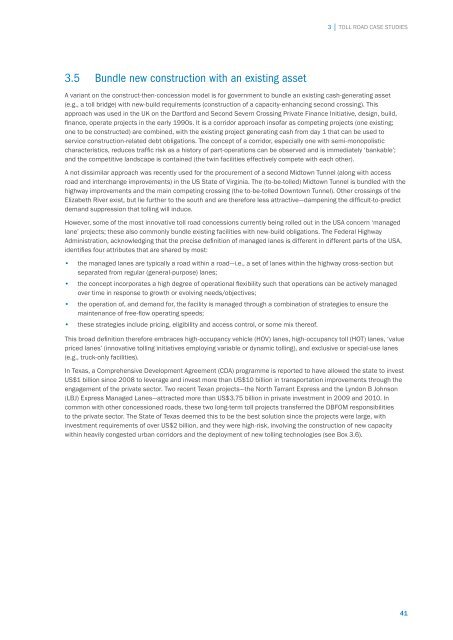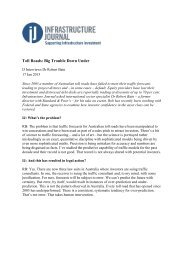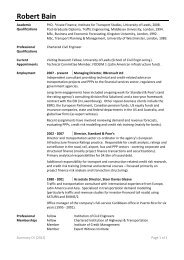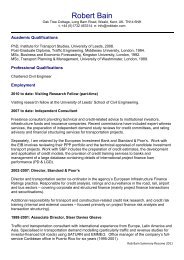Disincentivising overbidding for toll road concessions
Disincentivising overbidding for toll road concessions
Disincentivising overbidding for toll road concessions
- No tags were found...
Create successful ePaper yourself
Turn your PDF publications into a flip-book with our unique Google optimized e-Paper software.
3 │ TOLL ROAD CASE STUDIES<br />
3.5 Bundle new construction with an existing asset<br />
A variant on the construct-then-concession model is <strong>for</strong> government to bundle an existing cash-generating asset<br />
(e.g., a <strong>toll</strong> bridge) with new-build requirements (construction of a capacity-enhancing second crossing). This<br />
approach was used in the UK on the Dart<strong>for</strong>d and Second Severn Crossing Private Finance Initiative, design, build,<br />
finance, operate projects in the early 1990s. It is a corridor approach insofar as competing projects (one existing;<br />
one to be constructed) are combined, with the existing project generating cash from day 1 that can be used to<br />
service construction-related debt obligations. The concept of a corridor, especially one with semi-monopolistic<br />
characteristics, reduces traffic risk as a history of part-operations can be observed and is immediately ‘bankable’;<br />
and the competitive landscape is contained (the twin facilities effectively compete with each other).<br />
A not dissimilar approach was recently used <strong>for</strong> the procurement of a second Midtown Tunnel (along with access<br />
<strong>road</strong> and interchange improvements) in the US State of Virginia. The (to-be-<strong>toll</strong>ed) Midtown Tunnel is bundled with the<br />
highway improvements and the main competing crossing (the to-be-<strong>toll</strong>ed Downtown Tunnel). Other crossings of the<br />
Elizabeth River exist, but lie further to the south and are there<strong>for</strong>e less attractive—dampening the difficult-to-predict<br />
demand suppression that <strong>toll</strong>ing will induce.<br />
However, some of the most innovative <strong>toll</strong> <strong>road</strong> <strong>concessions</strong> currently being rolled out in the USA concern ‘managed<br />
lane’ projects; these also commonly bundle existing facilities with new-build obligations. The Federal Highway<br />
Administration, acknowledging that the precise definition of managed lanes is different in different parts of the USA,<br />
identifies four attributes that are shared by most:<br />
••<br />
the managed lanes are typically a <strong>road</strong> within a <strong>road</strong>—i.e., a set of lanes within the highway cross-section but<br />
separated from regular (general-purpose) lanes;<br />
••<br />
the concept incorporates a high degree of operational flexibility such that operations can be actively managed<br />
over time in response to growth or evolving needs/objectives;<br />
••<br />
the operation of, and demand <strong>for</strong>, the facility is managed through a combination of strategies to ensure the<br />
maintenance of free-flow operating speeds;<br />
••<br />
these strategies include pricing, eligibility and access control, or some mix thereof.<br />
This b<strong>road</strong> definition there<strong>for</strong>e embraces high-occupancy vehicle (HOV) lanes, high-occupancy <strong>toll</strong> (HOT) lanes, ‘value<br />
priced lanes’ (innovative <strong>toll</strong>ing initiatives employing variable or dynamic <strong>toll</strong>ing), and exclusive or special-use lanes<br />
(e.g., truck-only facilities).<br />
In Texas, a Comprehensive Development Agreement (CDA) programme is reported to have allowed the state to invest<br />
US$1 billion since 2008 to leverage and invest more than US$10 billion in transportation improvements through the<br />
engagement of the private sector. Two recent Texan projects—the North Tarrant Express and the Lyndon B Johnson<br />
(LBJ) Express Managed Lanes—attracted more than US$3.75 billion in private investment in 2009 and 2010. In<br />
common with other concessioned <strong>road</strong>s, these two long-term <strong>toll</strong> projects transferred the DBFOM responsibilities<br />
to the private sector. The State of Texas deemed this to be the best solution since the projects were large, with<br />
investment requirements of over US$2 billion, and they were high-risk, involving the construction of new capacity<br />
within heavily congested urban corridors and the deployment of new <strong>toll</strong>ing technologies (see Box 3.6).<br />
41






